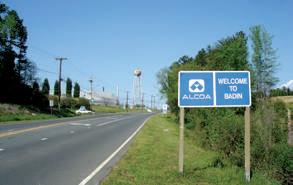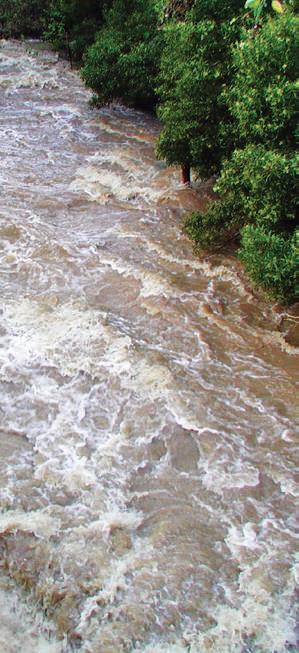
11 minute read
Global Polluter Caught by Yadkin River’s Cyber Sleuth
{{Ripples
Alcoa closed its Badin plant in 2002 but left behind a toxic legacy in the land and water at Badin Lake, which feeds into the Yadkin River.
Yadkin Riverkeeper Map Exposes Alcoa as a Global Polluter

When Alcoa, the giant aluminum producer, filed a request with the Federal Energy Regulatory Commission (FERC) to renew a 50-year operating license for four hydroelectric dams along the Yadkin River that powered its smelting plant in Badin, the company was confident North Carolina would issue the required permit — even though Alcoa closed the Badin facility in 2002. Since the plant closure, Alcoa has been selling the power on the open market, generating about $44 million a year.
Yadkin Riverkeeper Dean Naujoks had other ideas. Along with local business leaders and elected officials, he opposed the request, which failed to address numerous pollution problems linked to the Alcoa plant. For decades, Alcoa’s operations were responsible for the discharge of cyanide, fluoride, PCBs, solvents, metals, hydrocarbons, benzene, naphthalene and methane. Additionally, algae problems and low dissolved oxygen levels linked to their hydroelectric power operations had also been disregarded.
Throughout the relicensing process, Alcoa argued that the contamination issues should be separated from its relicensing effort, claiming the company had an “outstanding reputation locally, nationally and globally for its commitment to protecting the environment.” Naujoks decided to do some research of his own.
AbTech Industries offers technology to solve stormwater quality issues.

These environmental technologies provide cost effective solutions that protect
our critical water resources. Smart Sponge technology has the R O
unprecedented capability to remove dangerous contamination from stormwater.
There are solutions to water pollution!
I N D U S T R I E S
THE ALCOA WORLDWIDE POLLUTION MAP
CANADA
UNITED STATES
NORTH ATLANTIC OCEAN
ICELAND
HONOR
SOUTH ATLANTIC OCEAN
AUSTRALIA

He discovered a troubling worldwide pattern regarding Alcoa’s global operations and its spotty record addressing pollution issues. Alcoa, Naujoks discovered, had been cited and/or fined millions of dollars for environmental damages on nearly every continent.
Working with a communications firm in Raleigh, he created an interactive Google map detailing the environmental and community damage Alcoa has caused worldwide. Users can highlight affected communities to learn more about Alcoa’s impact and response.
North Carolina recently denied Alcoa’s permit. Governor Bev Perdue has filed a motion for the state to intervene in the FERC process to allow the state to recapture the license, stating, “The waters of the Yadkin River belong to the people of North Carolina.” No utility has ever been denied a FERC permit before in U.S. history. “Alcoa misled and damaged communities across the globe,” Naujoks said. “We felt it was unacceptable for Alcoa to claim to be a global environmental steward. This map exposes the truth for the whole world to see–the toxic legacy Alcoa has left behind virtually everywhere they’ve operated.”
The Alcoa Worldwide Pollution Map can be viewed at: www.yadkinriverkeeper. org/alcoapollutionworldwide
KATHY N AUJOKS
AUSTRALIA Dean Naujoks and his daughter, Krista Denali Naujoks, along the Yadkin River.
Yadkin Riverkeeper Recognized for Longtime Commitment to North Carolina Rivers Yadkin Riverkeeper Dean Naujoks has been selected for River Network’s 2009 National River Hero Award. River Network coordinates the annual National River Heroes Award to celebrate rivers and recognize the individuals who provide leadership, protect rivers and foster the growth and sustainability of watershed communities.
Since the fall of 2008, Naujoks has managed and implemented river advocacy programs for the Yadkin Pee Dee River watershed, a 7,221 square-mile area in western North Carolina. A longtime water quality advocate, Naujoks became the first Upper Neuse Riverkeeper in 2001. Prior to that he worked for the North Carolina Wildlife Federation, and was also appointed by the mayor of Raleigh, Charles Meeker, to serve on the joint government PCB Task Force to address PCB contamination in Crabtree Creek, a tributary of the Neuse River, in Wake County. A graduate of North Carolina State University, Dean created his own major in environmental policy and sustainable development.
The awards ceremony is held in conjunction with the River Network’s annual National River Rally. Since 2001, 28 outstanding individuals have been honored as National River Heroes. Dean received his award at the River Rally, held in Baltimore on June 1.

Petitcodiac Riverkeeper Celebrates 10th Anniversary P etitcodiac Riverkeeper celebrated its tenth anniversary this year. Since its launch on February 18, 1999, the organization has been the leading advocate for protection and restoration of the Petitcodiac and Memramcook River watersheds.
Over the past decade, Petitcodiac Riverkeeper has engaged in many issues affecting the health of the river system, most notably in advocating for the removal of the Petitcodiac causeway, and the restoration of fish passage in the river. While the organization continues to closely follow the progress of that project, it is also taking action on other pollution issues, including the state of the former Moncton riverside landfill, sewage issues, and pesticide usage. “Petitcodiac Riverkeeper has changed the way we think about our rivers and we will continue to push for a better watershed,” said Tim Van Hinte, Petticodiac Riverkeeper.
Broken beer bottles, twisted fishing line, plastic bags—picking up civilization’s callously discarded detritus is all in a day’s work for the new Charleston Waterkeeper, Cyrus Buffum, and his eager team of volunteers. Their inaugural cleanup—at Folly Beach, a barrier island located 15 minutes from downtown Charleston, S.C.—was a clear success and also something of a first for Waterkeepers—thanks to a chart developed by Buffum that inventoried the types of trash collected. Charleston Waterkeeper and Starbucks Coffee joined forces for the cleanup. Despite the threat of severe weather (which did arrive late in the afternoon), 150 volunteers showed up to pick up trash along the “Edge of America,” as Folly Beach is affectionately known. Over a three-hour period, volunteers collected well over 4,000 pieces of trash, and 265 cans and bottles were separated for recycling. Participants were encouraged to keep a tally of the types of refuse they collected. Items ranged from the worst culprit — cigarette ends — to what might be considered the strangest item of the day—a Barbie doll leg. The chart below shows the top 11 items collected. Charleston Waterkeeper’s First Cleanup a Success
150 Volunteers gathered to clean up Folly Beach. Over 4,000 pieces of trash were collected and properly disposed of.
2009 CHARLESTON WATERKEEPER/STARBUCKS FOLLY BEACH CLEANUP
Cigarettes / Cigarette Filters Straws, Stirrers Caps, Lids
Food Wrappers / Containers Beverage Cans Glass Beverage Bottles Cups, Plates, Forks, Knives, Spoons Cigar Tips Plastic Bags
Beverage Bottles (Plastic) 2 Liters Or Less Styrofoam (Chunks, Pieces, Peanut Shells, Etc.)


Charleston Waterkeeper has received a very generous donation: a boat from local supporters. The boat, a 1987 Starcraft, is now Charleston Waterkeeper’s first official patrol boat, and is a tremendous step forward for the organization. Charleston Waterkeeper Cyrus Buffum said he was thrilled that he can now respond to citizen reports of pollution or suspicious activity. “The more access we have, the more we can do to improve and protect these natural resources,” Buffum said.
With his new-found patrol ability, Buffum has undertaken the task of tracking abandoned boats. In collaboration with local photographer Olive Productions, Charleston Waterkeeper is preparing to launch a campaign targeting abandoned and derelict boats throughout Charleston’s waterways.
South Carolina has recently passed legislation banning the abandonment of watercraft. Abandoned boats not only pose a threat to the safety of recreational boaters, but are also environmental hazards, eyesores and economic burdens. However, while the statute is enforced by the Department of Natural Resources, the responsibility of removing these vessels falls to the local municipalities. “As a result, an everyman-for-himself environment has been created,” said Buffum. Charleston Waterkeeper has created a Google Map that displays the location of abandoned boats throughout the city’s waterways. In keeping with Waterkeeper’s tradition of grassroots activism, the map is made up of information supplied not by experts, but by the public. Within two days of its launch, nearly 30 abandoned boats had been identified and added to the map. “Mass collaboration changes everything,” said Buffum. You can view the map at: http:// charlestonwaterkeeper.wordpress.com/issues/ Patrol Boat Donated While Others Await Rescue
Who’ll stop the rain?

August 16 – 20, 2009 Anaheim Marriott Anaheim, CA, USA www.StormCon.com
Everyone at StormCon will.
StormCon is the world’s training ground for water pollution prevention.
Help spread the word by sending StormCon invitations at www.StormCon.com.
Stormwater, The Journal for Surface Water Quality Professionals is the premier publication for those on the frontlines of water pollution prevention and mitigation. To subscribe to this complimentary journal, visit www.StormH2o.com.
The mighty Fraser River is the longest river in British Columbia. Its watershed is a vast ecological, cultural and economic treasure chest, which drains more than a quarter of the province before it empties into the Pacific Ocean, through Vancouver. On April 19, Fraser Riverkeeper hosted its second annual Earth Day event: the cleanup of the Fraser River’s Pegleg Bar, one of the river’s numerous gravel bars. Pegleg, and other bars, provide important riparian zones for aquatic and terrestrial plants and animals. During the late winter and early spring, before the spring thaw begins, the gravel bars are exposed. After the thaw, the bars are largely submerged and are prized as sport fishing hotspots. But people continue to dump along the river and the refuse is trapped along these bars. At last year’s Earth Day cleanup, about 50 volunteers collected over four tons of waste material in the span of two hours: two-and-a-half tons of garbage and two tons of metal, including bicycles, household appliances, mattress springs, and other recyclables.
This year, Fraser Riverkeeper, working with the city of Chilliwack and other friends of the river, including British Columbia’s Minister of the Environment, Barry Penner—and with more than double the number of last year’s volunteers—pulled out 11 tons of waste, including the remains of a car and a washing machine.
In thanking everyone, Fraser Riverkeeper Doug Chapman spoke of making a difference large and small—to the river and to the planet. “The garbage you removed today will not be able to disintegrate and affect the wildlife that inhabits the river. And the plastics won’t end up in the large plastic ‘island’ in the North Pacific Gyre,” he said, in reference to the area of the Pacific twice the size of the United States that has become a giant trash basin for plastic waste. The Widening Gyre: Fraser Riverkeeper Earth Day Cleanup
EMILY EGGINTON
British Columbia’s Fraser River is home to some of the world’s most important salmon runs. Pegleg Bar provides easy access to the Fraser for recreational fishing but it has resulted in the accumulation of various types of garbage—from aluminum cans to couches. FRASER R IVERKEEPER FRASER R IVERKEEPER
CONGRATULATIONS! Waterkeeper Family Album West/Rhode Riverkeeper Chris Trumbauer and his wife Mary are proud to announce the birth of their daughter Josephine Eileen. Josephine was in such a hurry to come into the world that she couldn’t wait to get to the birthing center. Proving once again that Riverkeepers are jacks-ofall trades, Chris “delivered” her on the kitchen floor.
Vera Minina, Coordinator of Ecological Programs for Russian WATERKEEPERS, celebrated the birth of her daughter, Vera Sofia M. Koreshkova, on December 2, 2008. Вера Минина, Директор Екологических Програм для Russian WATERKEEPERS родила дочку Софиа М. Корешкова 2 декабря 2008 года. Russian WAT
HONOR
Milwaukee Riverkeeper Cheryl Nenn in the Riverkeeper boat at the end of another day on the water.
Milwaukee Riverkeeper Named 2009 River Champion T he River Alliance of Wisconsin has named Milwaukee Riverkeeper one of three River Champions for 2009. Milwaukee Riverkeeper, formerly Friends of Milwaukee’s Rivers, has been a staunch advocate for the health of the Milwaukee, Menomonee and Kinnickinnic River watersheds for the past 14 years.
The River Alliance cited Milwaukee Riverkeeper’s work tracking pollution spills, monitoring water quality and championing Milwaukee’s rivers at the municipal, state and federal levels. One of Milwaukee Riverkeeper’s biggest victories was getting the Kinnickinnic River listed as one of the nation’s Most Endangered Rivers. As a result of the designation, a federal- and state-funded $22 million cleanup project is removing 170,000 cubic yards of sediment containing PCBs and PAHs from the river’s bottom.
A focus of Milwaukee Riverkeeper Cheryl Nenn’s work has been advocating for improved sewage treatment. “Our sewage and drinking water systems may be less visible than our roads and railroads, but they are no less important,” said Nenn. “We’re facing a perfect storm of sorts in this country: antiquated and failing sewage infrastructure under our cities, increased wastewater from a population that has doubled since the 1940s, discharges of raw sewage to our waterways that threaten our public health, and lack of funding and political will to deal with these problems.”
She has called for the creation of a Clean Water Trust Fund that would invest in improving sewage infrastructure, developing new technologies and making sewer system upgrades and water quality protection a priority in federal and local budgets.








